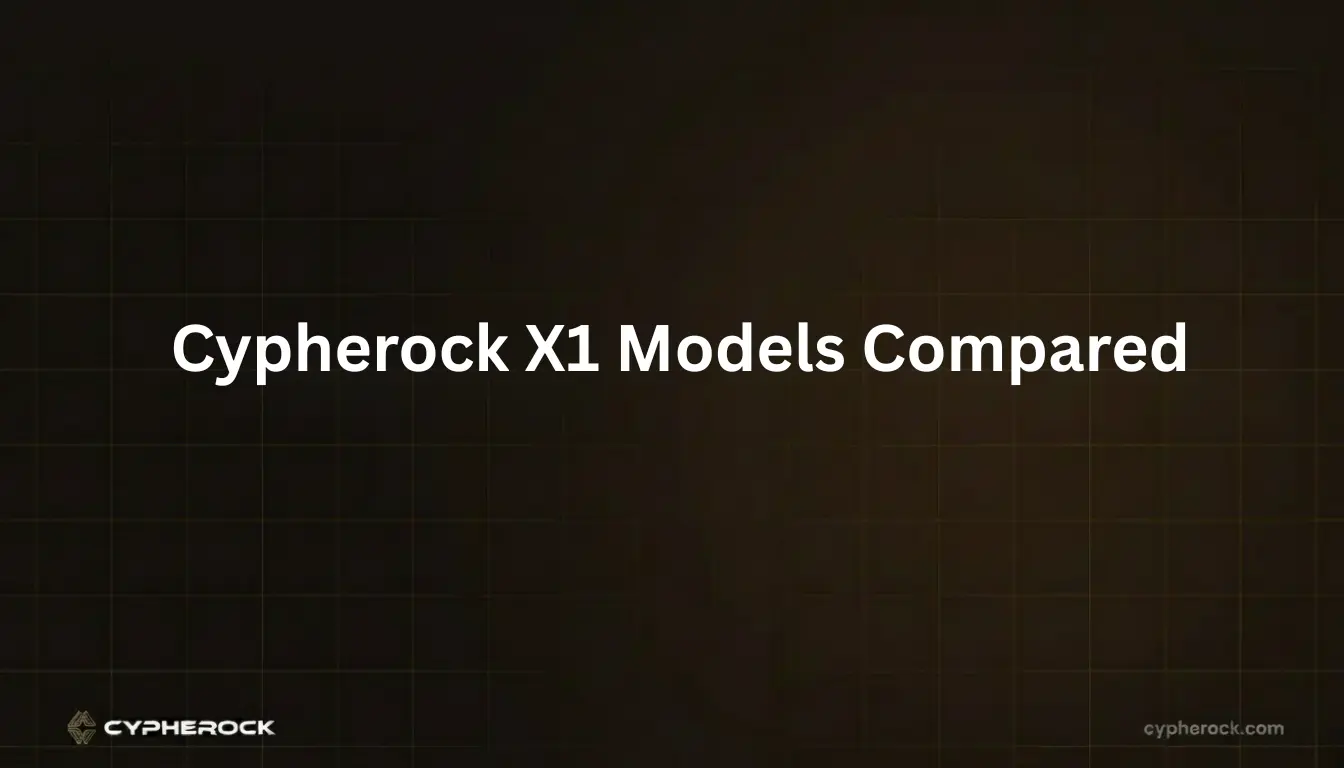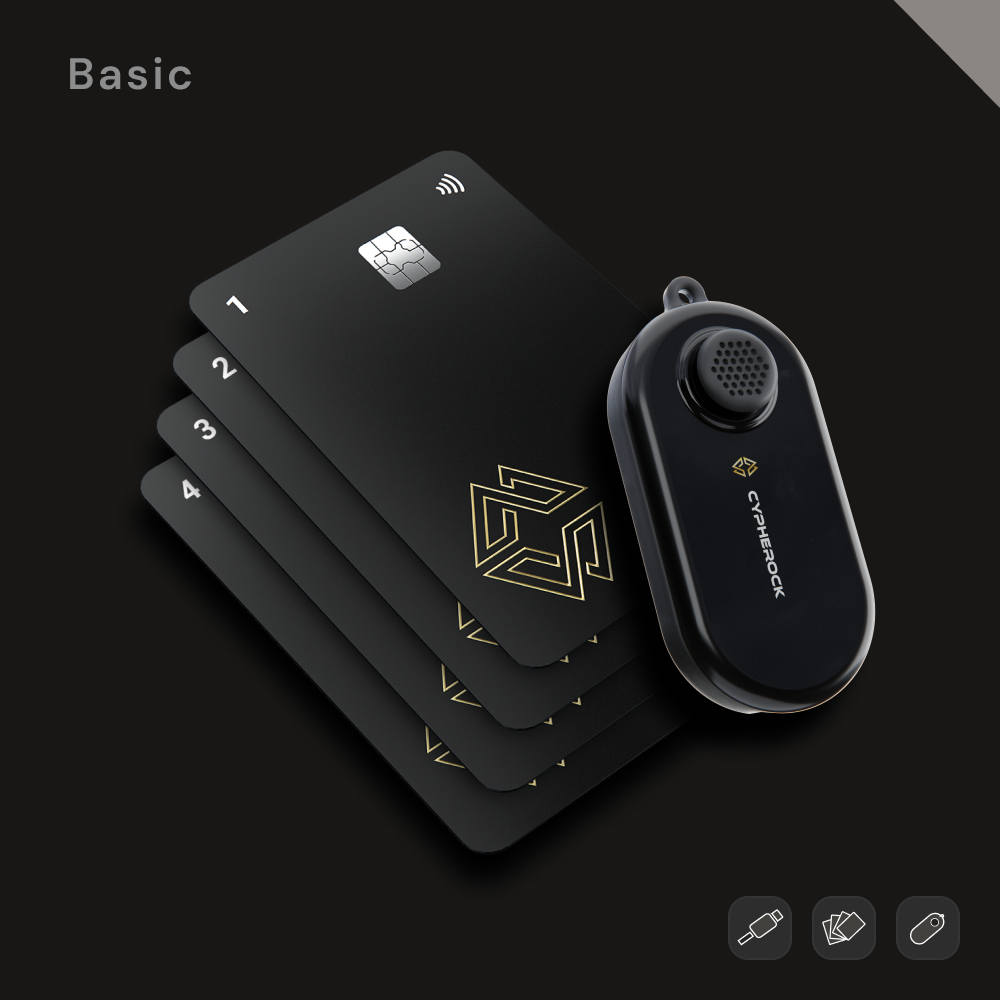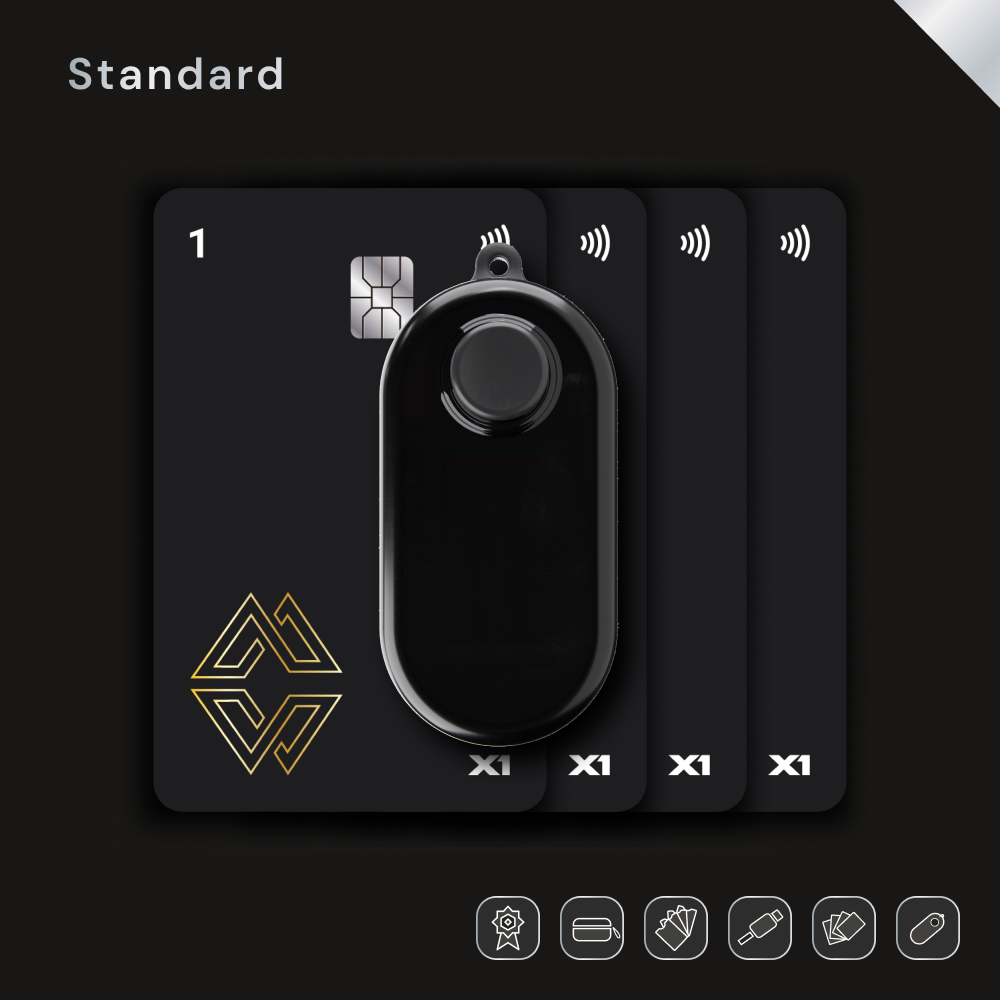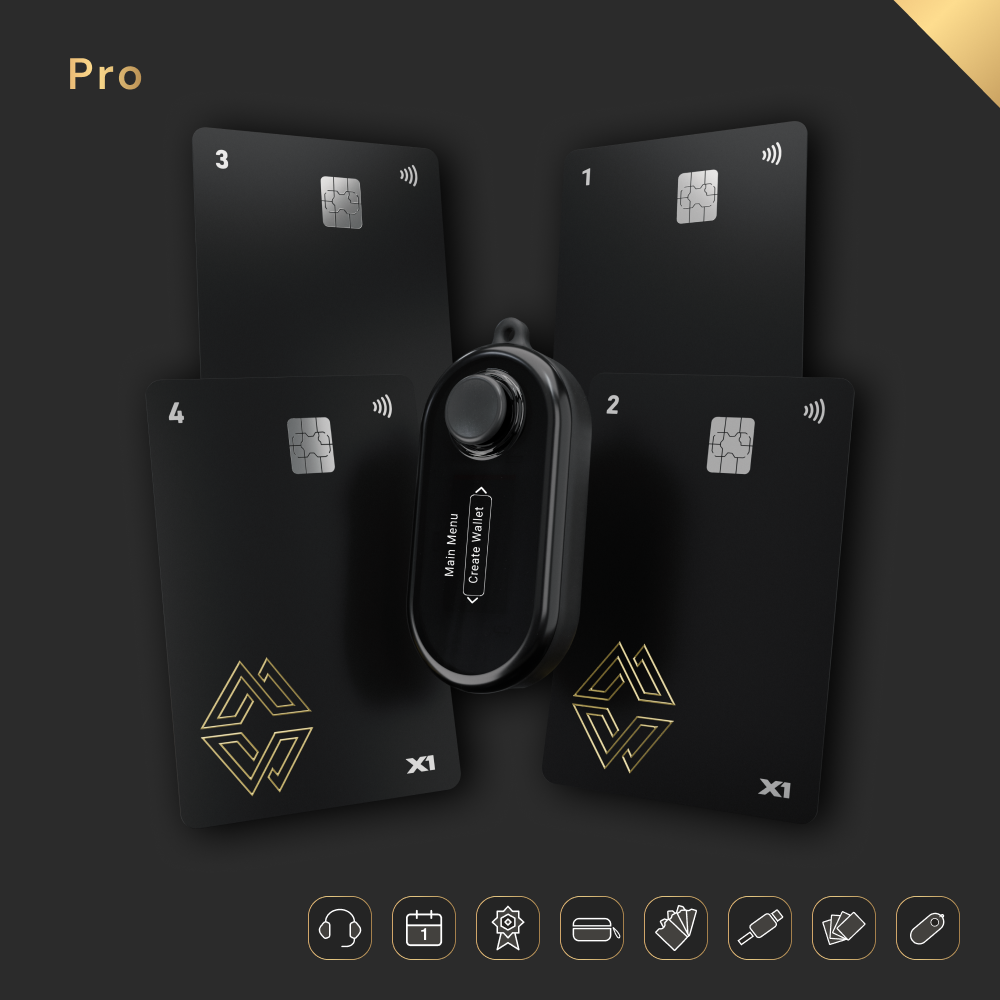
Choosing the right hardware wallet is a critical decision if you’re serious about crypto-asset security. The Cypherock X1 lineup offers a unique architecture, designed for self-custody with strong security, open-source transparency, and a tiered model to suit beginners through institutions. In this guide you’ll learn what each SKU includes, who it’s for, how it stacks up to other wallets (such as Tangem and Ledger), and how to pick the right one for you.

Price: USD $99
Box contents: Vault device, 4 NFC Cards, USB kit
Ideal for: Beginners, new holders with moderate value, users wanting strong security without extras.

Why buy it:
Limitations:
Scenario example:
You’re holding a low value portfolio (say $5k-$10k) of crypto as investment. You set up the X1 Basic, distribute the 4 cards across safe locations (home safe, bank deposit box, trusted family, etc.). Thanks to the multi-card model, even if one card is lost you retain recovery ability. You benefit from the robust architecture at an affordable price.
Mini Comparison (Tangem):
While Tangem offers a card-style wallet at low price (~US $79 for a pack) and is great for simplicity, its architecture is simpler (single card key per device, less redundancy, no vault only cards) and closed-source. Cypherock’s Basic offers stronger safeguards (multi-card threshold, open architecture), making it more suited for long-term, high-security storage even at entry price.
Price: US $179.
Box contents: Vault device, 4 NFC Cards, USB Kit, Hardcase, 3-Year Warranty.
Ideal for: Intermediate users, frequent travellers, active crypto participants who want more durability and longer protection.

Why buy it:
Limitations:
Scenario example:
You travel for work or crypto-meetups, and you carry part of your wallet with you. The hardcase protects your vault/cards in transit; you store cards in multiple safe spots, perhaps one in your travel pouch, one at home, one at family. You want longer warranty because you’re more active, so Standard makes sense and balances cost vs benefit.
Mini Comparison (Ledger Nano X):
Ledger’s device (~US $149) offers strong name recognition, Bluetooth, mobile app, but relies on a 24-word seed phrase and has a 2-year warranty. Cypherock Standard offers multi-card recovery, longer warranty, open-source, and reduces seed-phrase risk. If mobile/Bluetooth is less important than resilience and decentralization, Standard pulls ahead.
Price: US $249
Box contents: Vault device, 4 NFC Cards, USB Kit, Hardcase, 3-Year Warranty, 1-Year Gold Plan (Cypherock Cover) + Priority Support.
Ideal for: High-net-worth individuals, professionals, custodians or small institutions managing large portfolios and requiring full support ecosystem.

Why buy it:
Limitations:
Scenario example:
You’re an asset manager or a family office managing client funds or multiple large wallets. You want not only strong hardware security, but also priority recovery service, dedicated support, longer warranty, and infrastructure for custody and legacy. The X1 Pro gives you that. You distribute cards to trusted custodians, maybe with multi-location safe storage, you may log support incidents, you treat hardware as part of operational risk. Pro covers you.
Mini Comparison (Ledger + Tangem):
If you attempted to replicate this setup using Ledger (single seed) + Tangem (cards) you’d likely need multiple devices, complex redundancy, and still deal with seed-phrase risk and shorter warranty/support. Cypherock Pro unifies this: multi-card, decentralized, support, extended warranty, all in one package.
The heart of the Cypherock X1 security model lies in its NFC-based cards. Each wallet ship includes four cards (and the vault). Key specs: the cards employ EAL6+ secure elements (for the card chip) and use NXP JCOP3 architecture.
Key points:
Comparison with Tangem’s card model:
Tangem offers single card crypto wallets (you hold one card, tap it for action). While convenient, the redundancy and shard-based model aren’t present. If you lose a Tangem card, you may lose funds depending on the model. Cypherock’s card system is more complex, but more resilient for serious holdings.
Practical usage:
When you set up your X1, you pair the cards with your vault, distribute them (for example: one at home, one safe deposit at the bank, one with a trusted person, one in a remote location). Because you only need 3 of 4 (or the required threshold) to operate, you have flexibility and resilience. Later if you lose a card, you still maintain access and can request a replacement (if warranty/Gold Plan allows).
Note: The card model still requires physical security discipline, store cards separately, keep at least one backup location. The architecture helps, but your process matters.
The Vault is the “core” device that interacts with the cards and signs transactions. Key technical attributes: size ~3 × 6.4 × 1.5 cm, weight ~200 g, USB-C interface, OLED display (0.96″) and joystick navigation.
Key features:
Comparison to Ledger’s seed-phrase model:
Most hardware wallets (e.g., Ledger) rely on one seed phrase stored (or at least backed) by the user. With Cypherock, the private key is never stored in one place; instead shards are used. This increases resilience and reduces risk of single point failure.
User workflow:
During setup you connect the vault to your computer, initialize via companion software, pair the cards, then the vault will generate your wallet and distribute key shards to cards and itself. You then disconnect, store cards in different places, and use the system for cold storage.
Warranty and hardware-failure coverage are often overlooked in the crypto-wallet world, but when things break or get lost, they matter. Cypherock offers:
What does warranty cover? Typically manufacturing defects, hardware failure, device malfunction. Having a longer warranty means less replacement cost risk. For Standard and Pro users this is a big plus.
Extended coverage via Gold Plan (Pro model):
The Pro includes a 1-year “Gold Plan” (Cypherock Cover) which provides priority support, recovery assistance, and possibly expedited hardware replacement. It adds a service layer beyond standard warranty.
Comparison to competitors:
Buyer guidance:
The Gold Plan, branded “Cypherock Cover”, is included with X1 Pro. This plan offers premium service: priority support, dedicated assistance, hardware replacement escalation, and recovery workflows. It’s aimed at users where time / accessibility / service matter (business users, inheritance planning).
What’s included? Cypherock lists: priority call support, coverage beyond hardware failure, guided recovery assistance.
Why it matters:
Comparison to Ledger Vault / other enterprise solutions:
Ledger offers “Ledger Vault” for institutional custody (multiple devices, multi-sig, enterprise SLA) but that is separate and expensive. Cypherock Pro gives a strong self-custody option for smaller teams without full enterprise product cost.
Buyer guidance:
Open-Source Firmware & Audit Transparency
One of Cypherock’s strong differentiators, the firmware is open-source while still using certified secure elements. Many competitors have closed firmware or limited transparency, which can raise question marks for ultra-security users.
Asset & Token Support
The X1 supports over 9,000 coins and tokens, including major chains and many ERC-20/BEP-20 tokens. This breadth means you won’t outgrow the device quickly if you diversify holdings.
Physical Protection & Accessories
Higher SKUs include a hardcase (Standard and Pro) which protects the Vault and cards during storage/transport. Card sleeves (to reduce NFC wear) are also included. Good physical protection is often ignored but matters especially for travel or storage.
Security Certifications & Architecture
User Interface (UX)
While some wallets focus entirely on minimalism, X1 gives a joystick and OLED screen which offers on-device verification of addresses & transactions, important for high-value usage, clear screen and ease of navigation.
Design & Recovery Model
Security & Transparency
Pricing & Use Case
Verdict:
If you are storing modest amounts, prioritizing simplicity and mobility, Tangem is fine. If you want serious self-custody, future-proofing, redundancy and multi-location storage, Cypherock X1 is the better long-term choice.
Recovery & Key Storage
Connectivity & UX
Security Certifications
Service & Warranty
Price & Value
While Ledger may cost less upfront, the added protections of Cypherock (multi-card, no seed phrase, extended warranty) can offset cost for users storing serious value.
Verdict:
If you value mobility, mobile access, a familiar ecosystem and are comfortable with seed-phrase models, Ledger is solid. If you prioritize ultimate security, decentralisation, open-source transparency and multi-location recovery, Cypherock X1 leads.
Yes, it appears fairly priced for what you’re getting. Let’s map features to cost:
| Tier | Core Security Features | Warranty/Service | Price |
| X1 Basic | Multi-card + vault, open-source, EAL6+ cards | 1 year | US $99 |
| X1 Standard | Above + hardcase + 3-year warranty | 3 years | US $179 |
| X1 Pro | Above + Gold Plan + priority support | 3 years + service | US $249 |
Comparing with competitors:
When you store crypto for many years, replacement risk, hardware failure, support costs, recovery costs all matter. The X1 Standard and Pro tiers reduce long-term risk:
So, the upfront higher cost may pay dividends over time by reducing hidden costs (loss risk, downtime, support, replacement).
Purchase only from the official Cypherock store or authorized reseller.
Ensure tamper-evident seals are intact upon delivery.
Confirm box contents: vault, 4 cards, USB-C cable (and hardcase if Standard/Pro).
Setup Checklist
Q: Can I import an existing seed phrase from another wallet into Cypherock X1?
Yes, Cypherock supports importing BIP39 seed phrases and converting into its shard-based architecture. This lets you move existing wallets into X1 for better security.
Q: What happens if I lose the vault device itself?
Because your private key shards are on both vault and cards, losing the vault alone does not mean loss, provided you still have enough cards (threshold). You can pair a new vault and cards to recover.
Q: What if I lose one or more of the cards?
If you lose up to X cards (depending on threshold) you retain access via remaining cards + vault. You then replace the lost cards (standard/Pro warranty may help).
Q: Does Cypherock X1 have a mobile app?
Yes, Cypherock provides an official mobile companion app called cySync for both Android and iOS. You can download cySync from the Google Play Store and the Apple App Store.
Q: Is the wallet compatible with all cryptocurrencies?
It supports 9,000+ coins and tokens, covering major chains and many tokens. Always verify for any niche token you might hold.
Q: What if the company (Cypherock) ceases operations?
Because the firmware is open-source and your keys are stored on multiple physical components (vault + cards), you retain possession of your private key shards. The open architecture helps ensure you can still recover via community/tools, even if the company stops servicing.
Q: Is this suitable for India / crypto wallet India context?
Yes hardware wallets ship internationally, and because you hold keys yourself (not custodial), it aligns with self-custody best practices. Ensure you check shipping, tax/import obligations in India.
Here’s how to decide between the three models:
| User Persona | Recommended Model | Why |
| Beginner hodler (entry portfolio) | X1 Basic | Strong core security at lowest cost. |
| Frequent traveller/active user | X1 Standard | Adds hardcase, extended warranty, better resilience. |
| Professional/institution/large portfolio | X1 Pro | Full service layer (Gold Plan), priority support, top tier protection. |
All models share the same underlying architecture: multi-card + vault, EAL6+ cards, open source, audited design. The difference is in extras, physical protection, warranty, support. If you value security and resilience above convenience (especially mobile), the X1 lineup stands out in 2025.
For most serious users the Standard model offers the best balance of value vs protection. If you’re storing substantial holdings or need service support and legacy management, the Pro is definitely justified. If you’re just starting small, Basic gives you solid protection at minimal cost.
Ready to pick your hardware wallet? Explore the full Cypherock X1 lineup on the cypherock store and choose the model that matches your risk profile, usage scenario, and long-term security needs.
Quick Recommendations

| Feature | X1 Basic | X1 Standard | X1 Pro | Tangem | Ledger (comparable) |
| Price | US $99 | US $179 | US $249 | US $79 (3-card pack) | US $149 (Nano X) |
| Box Contents | Vault + 4 Cards + USB-C cable | Vault + 4 Cards + USB Kit + Hardcase + 3-yr warranty | Vault + 4 Cards + USB Kit + Hardcase + 3-yr warranty + Gold Plan + Priority Support | Cards only (NFC card model) | Device + USB + basic accessories |
| Warranty | 1 Year | 3 Years | 3 Years + Gold Plan | 2 Years | 2 Years |
| Support | Standard support | Standard support | Priority support | Basic support | Standard support |
| Open Source | ✅ | ✅ | ✅ | ❌ | ❌ |
